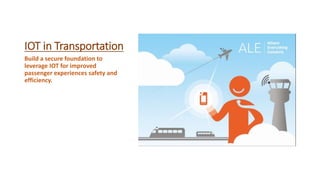
IOT Transportation Systems
- 1. IOT in Transportation Build a secure foundation to leverage IOT for improved passenger experiences safety and efficiency.
- 2. What is IOT and how it’s involving in the transportation system: IOT is the connection of your physical device to the internet. The internet of things (IOT) refers to the network of interconnected computer devices embedded in various objects, ranging from mobile devices and household appliances to vehicles and even structures. The IoT has the potential to transform the transport industry by profoundly altering how transportation systems gather data and information by bringing together the major technical and business trends of mobility, automation and data analytics. IoT refers to the networking of physical objects through the use of embedded sensors, actuators, and other devices that can collect and transmit information about real-time activity in the network.
- 3. How the IOT is changing the transportation system: • Improve the traveler experience • Smart road and traffic management • Parking • Bridge sensors • Bicycle and pedestrian monitoring and safety • Micro-navigation in public transportation • Airport and air travels • IOT in travel innovations
- 4. 5 Top applications of IOT in Transportation :
- 5. • Fleet management: The fleet management technology is slowly and gradually getting adopted with the improvements in operational efficiency, maintenance cost, fuel consumption, speed up accident response, GPS tracking, real-time business decisions are some of the key features fleet management offers. • Public transit management: It benefits to passengers. But tracking real-time location of the vehicle and knowing when it will arrive at a particular stop was always a challenge. The IoT has eradicated all the challenges that were faced in a public transit system and has enabled re-routing features to help people make alternate arrangements as real-time tracking of the vehicle is easily done. • Smart inventory management IoT in transportation has smart inventory management that acts as a catalyst telling the real- time information across the warehouse, distribution, and production center, which reduces the cost of inventory and improves the predictive maintenance.
- 6. • Optimal asset utilization: IoT in transportation enables the asset tracking features, which keeps track of the physical assets and their information, like location, status etc. With Biz4Intellia, an end-to-end IoT provider, one can track the real time location of their truck and can know how much load there is on the trailer of the respective truck. • Geo-fencing: IoT in the transportation industry is the most benefited from geo-fencing. Geo-fencing have advanced form of GPS that captures the location of an asset or device with coordinates of a particular area. Geo-fencing helps in starting the automated tasks.
- 7. Impact of IOT in transportation • Cars will be connected: IOT already have connected systems that allow the drivers to connect their smartphones and use various apps, navigate the roads, listen to satellite radio, request roadside assistance, find open parking spaces, remotely lock/unlock the doors and view streaming videos.
- 8. • Automobiles as sensors: Sensors have been implemented in automobiles, which enables them to achieve several tasks. By connecting all the sensors on automobiles to IOT, vehicles can communicate with each other, collect data off each other and store it in the cloud infrastructure, which can further be used and analyzed. • Infrastructure will be connected: IOT will allow one to create connections amongst different vehicles, and between the vehicle and transportation infrastructure.
- 9. Conclusion: IOT would support innovation in the transportation industry. We should harness the power of IoT. But unfortunately the adoption rate of IoT in transportation is very low. However, this will change soon and we will see IoT being incorporated into vehicles, which will greatly impact the industry and present new opportunities that seemed impossible a few years back.
